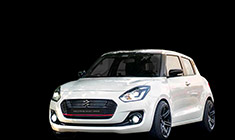News
Different Modification options for your 4x4 with its Pros and Cons
Provided an unconstrained budget, there is always a chance of going overboard with modification beyond need. The sweet spot for aesthetics vs functionality for every mod is often missed in the pursuit of uniqueness.
BHPian Blooming Flower recently shared this with other enthusiasts.
This post has prompted me to pen down a long reply which was circling in my head for a few years. (Mods please move to a new thread if deemed suitable)
To Modify or Not To Modify
With the advent of the new Thar in the Indian market, it’s fascinating to see the surge in off-roading enthusiasts in India. Later, Jimny only took a minuscule share of the entire 4WD community. Off-roading has become increasingly popular, attracting thrill-seekers of all ages. Whether it’s snowy trails, sand dunes, slushy paths, or rocky landscapes, the allure of extreme terrain is hard to resist. And 4x4 SUVs are the ideal vehicles for this adventure. These vehicles provide better traction and grip, making off-roading a thrilling experience. Some people argue that the Alto is like a nimble mountain goat, capable of impressive feats in the right hands. However, I firmly believe that 4WD vehicles, by their intrinsic capabilities, can truly shine even in the hands of novice drivers. At the same time, as the 4WD market boomed, the aftermarket modification trend reached unprecedented heights. I’ve observed enthusiasts investing twice or thrice the car’s original cost in customizing their vehicles. Interestingly, there’s no definitive right or wrong when it comes to modifications. Some focus on cosmetic enhancements purely for beautification, while others opt for robust mechanical upgrades to enhance off-road capabilities. And then there are those who strike a balance between the two. Personally, before choosing any modification, I always ask myself three critical questions:
1. Why to modify?
Understanding the purpose behind the modification can help ensure that it adds value and enhances the vehicle’s performance or aesthetics in a meaningful way.
2. What is to be modified?
Deciding on the specific parts or aspects of the vehicle to be modified can help focus the modification process and prevent unnecessary or redundant changes.
3. How is my use case pitted against the cost for the mod?
Evaluating the cost-effectiveness of the modification in relation to its utility for the owner’s specific use case can help ensure that the modification is a worthwhile investment. But looking at the current scenario, I can ascertain that the number of ‘catalogue cars’ is infesting the market by leaps and bounds.
Now, what is a catalogue car?
During an informal chat with the owner of a well-known 4WD modification workshop, we bumped into this coinage. Nowadays, most people with no fixed budget drive into their showroom, and a comprehensive catalogue along with some actual sample parts displayed there are served as a ready-to-eat platter. Many of the customers, without even knowing the use case jump into opting for almost everything from the catalogue (perhaps with the intents to stand out in the crowd). And some due to budget constraints get their 4WDs modified in a phased manner. In both cases, those three questions are never invoked.
I have prepared the following visual representations to cover the entire spectrum, and I shall look forward to where your 4WD fits in.
Before going into the graphs, let's look into some common modifications we think of with pros and cons.
Common 4WD Modifications
1. Cosmetic Modifications:
Purpose: These mods focus on enhancing the appearance of the vehicle. They don’t necessarily improve performance but add a personalized touch.
Examples:
- Body Wraps and Paint: Custom colors, graphics, or vinyl wraps.
- Alloy Wheels: Upgraded rims for aesthetics.
- LED Lights: Light bars, underbody lights, or grille lights. (Often illegal in some states of India)
Pros: Aesthetic appeal, individuality.
Cons: No functional improvement.
2. Performance Enhancements:
Purpose: These mods aim to boost the vehicle’s performance, whether on-road or off-road.
Examples:
- Suspension Upgrades: Lift kits, stiffer springs, or adjustable shocks.
- Engine Tuning: ECU remapping, air intakes, exhaust upgrades.
- Tires: Off-road tires for better traction.
Pros: Improved handling, better off-road capability.
Cons: May affect ride comfort or fuel efficiency.
3. Off-Road Modifications:
Purpose: Geared toward tackling challenging terrain.
Examples:
- Skid Plates: Protect vital components from rocks.
- Winches: For self-recovery.
- Snorkels: Allows for water crossings, cleaner air intake
- Off-Road Bumper: Better protection during OTR (Grey area in terms of MV rules)
- Lift Kit: To accommodate bigger tires and improving the GC.
- Low-range Gear Set: To improve crawl ratio.
Pros: Enhanced off-road capability.
Cons: May reduce on-road comfort.
4. Utility and Storage Mods:
Purpose: Enhance practicality and storage capacity.
Examples:
- Roof Racks: Carry gear, tents, or spare tires.
- Drawer Systems: Organize tools and equipment.
- Rear Bumpers with Tire Carriers: Holds spare tire.
- Large Capacity Fuel Tanks: For long-haul run
Pros: Convenience, versatility.
Cons: Added weight affects fuel efficiency.
The Spectrum of Modifications
Now, let’s explore where your 4WD fits in the spectrum:
1. Catalogue Cars:
Description: These are vehicles modified using pre-designed packages from catalogues. Customers choose from a menu of options.
Characteristics:
Pros: Quick and convenient, consistent quality.
Cons: May not align with individual needs, lacks personalization.
Example: Opting for a full catalogue package without considering specific use cases.
2. Customized Phased Mods:
Description: Gradual modifications based on budget and priorities.
Characteristics:
Pros: Tailored to individual preferences, cost-effective.
Cons: May take longer to achieve desired setup.
Example: Starting with essential mods (e.g., tires, suspension) and adding more over time.
3. Purpose-Driven Mods:
Description: Thoughtful modifications aligned with specific use cases.
Characteristics:
Pros: Optimized for the intended purpose, balanced approach.
Cons: Requires research and planning
Example: Enhancing off-road capabilities for weekend adventures.
The list can be never-ending given the plethora of options available in the market. Provided an unconstrained budget, there is always a chance of going overboard with modification beyond need. The sweet spot for aesthetics vs functionality for every mod is often missed in the pursuit of uniqueness. For example, let the following pic do the talking. None of the extremes conforms to any viable use case, save 'looks' (which is often very subjective). These all seat at the right-most point of the curve (refer graph next to the pic.)
Coming back to the graph— people might have polarized opinions, but these are approximate representations that vary with each mod. Where do you see your 4WD in the visual matrix?
Also, please let us know your preferred mod list and the respective vehicle details.
Check out BHPian comments for more insights and information.



















